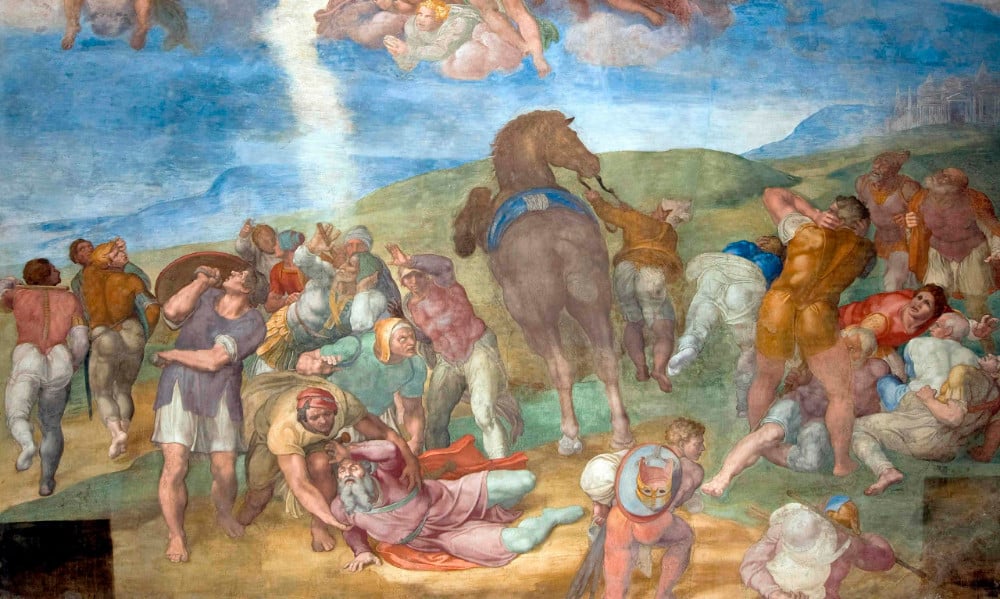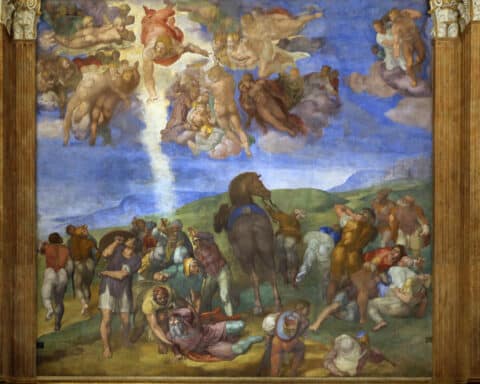To Paul of Tarsus, the problem (and what he should do about it) looked perfectly clear: This detestable new sect was a threat to his beloved Judaism and had to be destroyed. With that end in view, he was on his way to Damascus intending to continue his campaign against the Christians there. Then something unforeseen happened — something so remarkable that it’s recorded no less than three times in the New Testament.
Here is how Paul — the name he now took for himself — described it:
“On that journey as I drew near to Damascus, about noon a great light from the sky suddenly shone around me. I fell to the ground and heard a voice saying to me, ‘Saul, Saul, why are you persecuting me?’ I replied, ‘Who are you, sir?’ And he said to me, ‘I am Jesus the Nazorean whom you are persecuting.’
“I asked, ‘What shall I do, sir?’ The Lord answered me, ‘Get up and go into Damascus, and there you will be told about everything appointed for you to do.’ Since I could see nothing because of the brightness of that light, I was led by hand by my companions and entered Damascus” (Acts 22:6-11).
In Damascus, Paul was received as a new convert by Jesus’ local followers. From that point on, much of the rest of the Acts of the Apostles is the story of Paul and his ministry as the “Apostle of the Gentiles.” It is a sometimes harrowing account of a man’s heroism and perseverance — and sometimes outrageous chutzpah — in carrying the Christian message to a pagan society not always pleased to hear it. And it makes it abundantly clear why Pope St. John Paul II called him Jesus’ “herald.”
Choosing Paul
Until that turning point on the road to Damascus, there was nothing in Paul’s background or career to suggest anything of the sort. Quite the contrary, in fact.
He was born around A.D. 5 in Tarsus, a busy trading city on the southeastern coast of today’s Turkey. His parents were devout Jews of the Pharisee persuasion. As we know from the Gospels, Pharisees, years later, were to be deadly enemies of Jesus. At their best, however, they were high-minded reformers in the Judaism of that day, eager to uphold faithful observance of the Law of Moses.
In Tarsus, the youth learned the trade of tentmaking, then as a young man traveled to Jerusalem for religious studies under the eminent rabbi Gamaliel.
Although Christianity was then in its early days, hostility toward it was already on the rise. When local Jews took offense at the Christian deacon Stephen, Saul watched approvingly as others stoned Stephen to death and then turned to be an active persecutor himself. “Entering house after house,” Acts reports, “dragging out men and women, he handed them over for imprisonment” (Acts 8:3).
Then came that encounter with Jesus on the road. Saul, the persecutor of Christians, was transformed in a literally blinding flash into Paul, an evangelizer for Jesus Christ.
But why did God reach out in this way to a sworn enemy of Christ? As always, God had his reasons, not all of them necessarily known to us. But this much is clear: Wrongheaded though he was in hating Christians, and now that he knew better, his energy, intelligence and zeal made him particularly useful to the Lord.
Between roughly A.D. 45-58, St. Paul made three major missionary journeys during which he traveled through much of Asia Minor and eventually Macedonia and Greece. Typically, on arriving in a new town, he began by speaking in the local synagogue to the Jewish community, then, if he got a cold shoulder there — as often happened — he would preach the Good News of redemption in Christ to gentiles. Sometimes, he and his message were received joyfully; other times, they were violently rejected, even at risk to his life.
A herald of Jesus
Paul is unsurpassed as a chronicler of his agonies and ecstasies in the service of Jesus as in this vivid passage in his second letter to his converts in the Greek city of Corinth: “Five times at the hands of the Jews I received forty lashes minus one. Three times I was beaten with rods, once I was stoned, three times I was shipwrecked, I passed a night and a day on the deep; on frequent journeys, in dangers from rivers, dangers from robbers, dangers from my own race, dangers from Gentiles, dangers in the city, dangers in the wilderness, dangers at sea, dangers among false brothers; in toil and hardship, through many sleepless nights, through hunger and thirst, through frequent fastings, through cold and exposure” (2 Cor 11:24-27).
Then, shifting gears, he speaks of “a man” — himself, of course — who has been “caught up into Paradise” and granted extraordinary revelations. After which he hastens to note that he suffers from an unspecified, chronic affliction — “a thorn in the flesh was given to me, an angel of Satan” — that serves the Lord’s purpose by keeping him humble. Paul concludes, “I am content with weaknesses, insults, hardships, persecutions, and constraints, for the sake of Christ;e for when I am weak, then I am strong” (2 Cor 12:1-10).
Along with being a powerful evangelizer, Paul was an important source of Christian doctrine. The epistles that he addressed to new Christians whom he’d evangelized to strengthen them in the Faith contain passage upon passage of teaching fundamentals to the Faith we profess today as members of the Church.
Included are such crucial topics as the nature and mission of Jesus Christ — the redemptive significance of his life and death, Jesus’ bodily resurrection, the effects of baptism in Christ, Jesus’ real presence in the Eucharist, the Church as the mystical body of Christ, the offices and charisms found in the Church, the justifying power of faith in Christ, and numerous moral norms together with a brief exposition of natural law as “the law are written in their hearts” (Rom 2:15).
A lasting legacy
Of central importance in Paul’s career was his sometimes acrimonious argument with the Judaizers — Jewish converts to Christianity who held that gentile converts should receive circumcision and observe Jewish dietary laws. Paul strenuously rejected that viewpoint, not just because of the undue burden it placed on gentile converts but also and especially because it implicitly denied the radical newness of faith in Christ and its definitive character.
Eventually, the argument was settled by a gathering known to us as the Council of Jerusalem. After St. Peter spoke tellingly in support of Paul’s position, Paul proceeded to make his case. The assembled Christian elders then decided in favor of Paul, with only a few minor add-ons for the gentiles to heed. Not only was Paul vindicated — the Church had been set firmly on the path of evangelization it still follows.
After the Jerusalem council, Paul set forth his own fundamental position with his customary vigor in an epistle to Christians in the region of Galatia: “I have been crucified with Christ; yet I live, no longer I, but Christ lives in me; insofar as I now live in the flesh, I live by faith in the Son of God who has loved me and given himself up for me” (Gal 2:20).
Around A.D. 65, in Rome by now, St. Paul was executed by beheading during the persecution of Christians ordered by the emperor Nero. But his indomitable spirit and soaring words live on.
That dramatic turning point on the road to Damascus had powerful consequences — for Paul of Tarsus and, ever since, for Jesus’ Church.
Russell Shaw is a contributing editor for Our Sunday Visitor.





